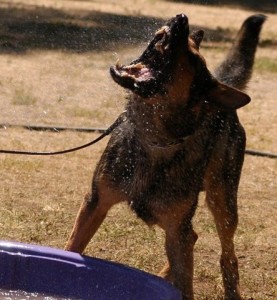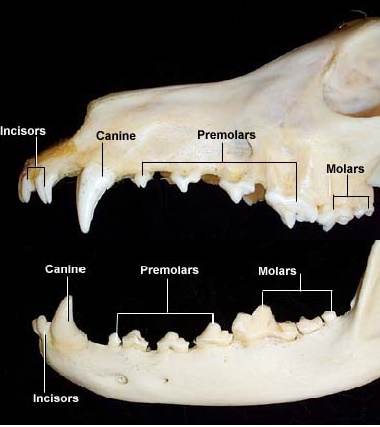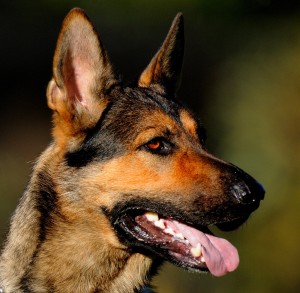The Canine Mouth
 February is National Pet Dental Health Month, making this the perfect time to discuss the canine mouth. The mouth of a dog is often a early window into its overall health. Bad breath, stained teeth, plaque and tartar buildup, and gingivitis all provide valuable clues as to what may be happening inside. Let’s take a closer look!
February is National Pet Dental Health Month, making this the perfect time to discuss the canine mouth. The mouth of a dog is often a early window into its overall health. Bad breath, stained teeth, plaque and tartar buildup, and gingivitis all provide valuable clues as to what may be happening inside. Let’s take a closer look!
The Canine Mouth
The dog’s mouth is uniquely adapted for its role as a carnivorous predator. The dog has 42 teeth, with 21 teeth on each side (left and right), and four general types of teeth (incisors, canines, premolars, and molars). Each type of tooth has its own particular function, and their unique shapes follow this purpose.
 There are four canine teeth (two upper, two lower), which were originally used for helping hold prey and preventing it from getting away. Because of this, the canine teeth have very deep and long roots that are longer than the visible portion of the tooth. This was to ensure that these teeth did not get ripped out easily, which was important if the prey was struggling to get away from the dog’s grip.
There are four canine teeth (two upper, two lower), which were originally used for helping hold prey and preventing it from getting away. Because of this, the canine teeth have very deep and long roots that are longer than the visible portion of the tooth. This was to ensure that these teeth did not get ripped out easily, which was important if the prey was struggling to get away from the dog’s grip.
There are 12 incisors (six upper, six lower) that sit between the canine teeth. These are the small “front teeth” of the dog. The incisors have a rather sharp surface; these teeth are used for stripping meat from bones, and are also used for grooming when the dog nibbles on their fur or skin. If you have ever given your dog a raw meaty knuckle bone or rib bone, then you have seen these teeth in action. The dog often holds the bone down with its paws, and begins to strip the meat off by pulling upward with those front incisors.
There are a total of 16 premolars, with eight on each side (four upper and four lower). The premolars also have sharp edges for shearing meat, particularly the fourth premolar on the upper jaw. This fourth premolar, combined with the lower first molar, are called the carnassial teeth. The carnassial teeth are the main set of teeth used to chew and shear through skin, meat, and bone. Any time a dog chews on a raw meaty bone or chew toy, these teeth are being used, which gives the dog its characteristic chewing posture (bone between the paws, with the head tilted to the side). This fourth upper premolar and first lower molar are significantly enlarged compared to the rest of the teeth, which is what allows them to do their job.
Finally, there are 10 molars, five on each side, with only two in the upper jaw, and three in the lower jaw. Other than the enlarged first lower molar, the dog’s molars are quite small, with pointed surfaces. Dogs lack the large flat molars that other species use to grind up plant matter; this is a further adaptation to their ancestral predatory diet of other animals. The dog’s molars are used to help crush bone before swallowing the large chunks of its meal.
The Individual Tooth
Each tooth consists of the enameled crown above the gum line, which covers and protects the softer dentin underneath the enamel. Underneath this is the pulp, the sensitive part of the tooth that contains all the live tissue, nerve endings, and blood vessels. This pulp can be exposed if a dog has a fractured tooth or has worn down its teeth excessively; both of these can cause significant pain to the dog, since the sensitive nerve endings are now exposed. This usually results in a need to either cap the tooth, or pull the tooth out completely. Each tooth has a large root that extends into the jaw below the gum line, and is further anchored by the periodontal ligament to the jaw. These deep roots can make dental extractions (“pulling teeth”) a complicated endeavor, particularly for the “strategic teeth” like canines and the carnassial teeth.
The Importance of Clean Teeth and Healthy Gums
 The condition of a dog’s teeth and gums are linked to its overall health, making this a very important aspect of a dog’s overall care. Normally, these teeth should be white and clean, with no tartar. Gums should be pink and bright, tight against the tooth. This photo on the left, for example, displays teeth that are in excellent condition. The four year-old dog in the photo shows clean white teeth, with little to no tartar present on the teeth. The gum line is moist, healthy, and tight against the teeth.
The condition of a dog’s teeth and gums are linked to its overall health, making this a very important aspect of a dog’s overall care. Normally, these teeth should be white and clean, with no tartar. Gums should be pink and bright, tight against the tooth. This photo on the left, for example, displays teeth that are in excellent condition. The four year-old dog in the photo shows clean white teeth, with little to no tartar present on the teeth. The gum line is moist, healthy, and tight against the teeth.
By contrast, a dirty mouth means bacteria and waste are constantly streaming through the dog’s body. In fact, periodontal disease has been show to negatively impact many major organs, including the heart, liver, and kidneys. This is crucially important in aging dogs, as the heart, liver, and kidneys often weaken and can lose some of their function as the dog moves into its geriatric years. This link between periodontal disease and ill effects on these very same organs is one powerful reason to keep your dog’s teeth and gums in top shape!
A clean mouth is more than just aesthetically pleasing to the eye. Next blog, we will discuss ways to keep your dog’s teeth and gums looking their best!

